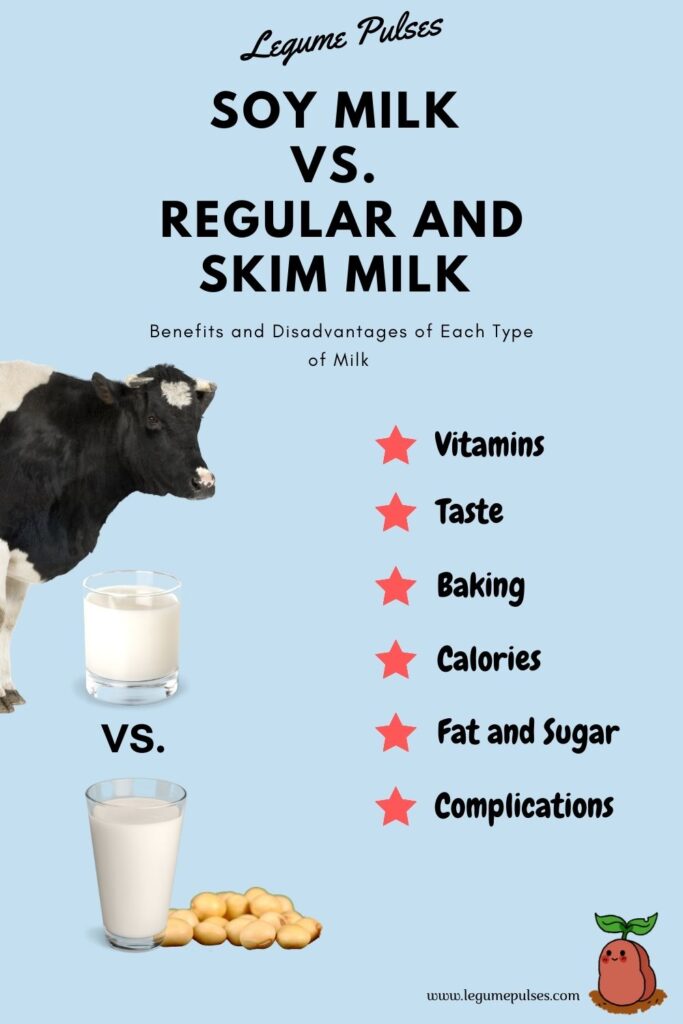Soy milk vs. regular milk and skim milk, which milk is the better choice?
How many of us grew up having a big glass of milk for breakfast But now we have a wide range of alternatives such as goat’s milk and skim milk. Today there is also plant-based milk which offers a great alternative to animal milk, and one of the most popular is soy milk. But, which milk is the better choice? I will compare soy milk vs. milk and skim milk.

Milk 1: Soy milk (What is soy milk?)
Each kind of milk contains different nutrients and benefits. Of course, regular dairy milk is produced differently from plant-based milk. Soy milk, for example, is made by soaking dried soybeans in water before boiling. The beans are then ground down, and the fibrous material is removed. Soy milk is a stable emulsion of protein, water, and oil.
Milk 2: Regular milk and skim milk (Cows milk is natural, but most milk is not organic).
If cows are not treated with antibiotics, the farmer may be certified organic. But there are strict requirements before the farm is certified organic. I believe the requirements also extend to the food cows eat. Therefore, most farms and milk are not registered as organic. And this can lead to another debate. Are organic farms as hygienic and clean as non-organic farms? Or are the cows healthier on non-organic farms? But, there are strict regulations to prevent traces of antibiotics in milk used for human consumption.
What is more important to you, the taste or health benefits?
I’d say most people are not too concerned with the health benefits of each milk. Many people would choose taste over the nutritional benefits. If you are vegetarian or need to decide which milk to use.
In this article, I will discuss three different types of milk.
- soy milk
- regular cows milk
- skim milk
I’ll give more information about each of the different kinds of milk and the nutrients they contain. I’ll also mention the possible health benefits and some disadvantages. I’m not a food scientist or have any medical background. However, I have tried to research carefully to provide you with the best possible information.
Soy milk nutritional benefits
How many calories are in soy milk?
A full cup of soy milk served provides 100 calories if the soy milk is unsweetened. However, check the label carefully, as sweetened soy milk such as chocolate soy milk may contain over 150 calories per cup.
Soy milk is full of protein.
Also, a full cup of soy milk contains about 8 grams of carbohydrates and approximately 7 grams of protein. However, the number of carbohydrates, protein, and calories is comparable to regular cow’s milk. Also, soy milk contains 4 grams of fats and 0.5 grams of saturated fats. If you’re lactose intolerant or vegetarian, soy milk could provide a vegan alternative to traditional dairy milk. (do Amaral Santos, da Silva Libeck & Schwan, 2014).
Soy milk may lower your cholesterol.
Soy milk lacks cholesterol and is low in low saturated fat. And soy milk could be a better choice if you have high cholesterol. A research study by the Stanford School of Medicine showed that drinking soy milk could lower cholesterol in your body. However, like everything, drink soy milk in moderation. Because another study indicates consuming a large number of soy products could disrupt the thyroid system. It sounds like the egg debate all over again.
Essential fatty acids
Soy milk has numerous benefits since it is prepared naturally to provide a nutritious drink full of essential minerals, vitamins, fiber, and protein (Michaëlsson et al. 2014). Also, soy milk may lower your cholesterol, so it’s a healthy alternative to regular milk. If your family has a history of heart disease or high cholesterol, soy milk could be a good option. Soymilk also contains omega- 6 and omega-3 that may reduce the risk of heart disease. As you may know, Omega-3 and Omega-6 as essential fatty acids. They are called essential fatty acids for a good reason, your body needs them.
Unsweetened soy milk could be the healthier option.
If you’re into health and fitness, unsweetened soy milk could be a good choice. Also, if you are getting a little podgy around the midriff, then unsweetened soy milk could be the way to go. After all, why ruin the health benefits of soy milk of having low calories by adding sugar.
Does soy milk have calcium?
Okay, you’ve heard regular milk has calcium, and you’re right. Regular milk contains a high amount of natural calcium. However, soy milk is often fortified with calcium.
Soy milk contains phytoestrogen and calcium for bone health.
As an added bonus, soy milk also contains phytoestrogen. This occurs naturally in plants. Soybeans have a lot of phytoestrogens that may prevent bone loss as you age. And drinking soy milk with added calcium could help prevent osteoporosis.
And if you want to learn the health benefits of drinking soy milk, click the link to read more.
Disadvantages of soy milk
Despite the heath benefits of soy milk, it is wise to look at the potential disadvantages. Cow’s milk is full of nutrients. After all, the purpose of regular milk is to provide all the essential nutrients for growing calves.
Soy milk has added calcium.
Soy milk does not provide much naturally occurring calcium. If you have young children, you may want to reconsider changing from regular milk to soy milk. Calcium is essential to develop strong bones in children, and whole milk can provide the daily requirement. It may come as no surprise that many health professionals recommend drinking regular milk enriched with calcium.
Some manufacturers may use a thickening additive made from kelp.
Another disadvantage of soy milk is some manufacturers use Kombu. A type of kelp that is used to thicken soy milk. Kelp is considered healthy, but it may cause complications such as increased iodine in the body. Iodine is necessary for your thyroid. But if you have thyroid problems, drinking soymilk may not be recommended. It is also prudent to monitor your iodine intake if you drink soy milk containing Kombu. As it may put you above the RDA.
Some people have a reaction to Kombu.
There is also research to indicate that the kelp additive may cause digestive problems and thyroid-related issues. This may be due to an adverse reaction to the kelp. Or the increased iodine in your diet. Try not to drink too much soy milk because drinking too much soy milk may cause adverse side effects such as stomach problems.
We have not been drinking soy milk for thousands of years.
Alternatively, if you are not vegetarian, you may want to continue drinking regular milk. After all, we have been drinking animal milk such as cow’s and goat’s milk for thousands of years. Apart from lactose intolerance drinking regular milk does not cause severe health problems. If you drink in moderation.
Okay, I mentioned calcium is added to soy milk, but did you know that other vitamins are also added? Vitamin A, vitamin D, riboflavin, and vitamin B12 are also added to soy milk. This may be a benefit. However, nothing beats good old-fashioned regular milk for nutrient density.
Cows milk is not a fad.
I believe regular milk has numerous health benefits. And regular milk is not a new fad, as it has been tried and tested for hundreds of years. Although we are told to avoid fat, people now understand it may not be that bad for us after all.
According to a research review that was conducted by the European Journal of Nutrition, full-fat dairy consumption was associated with:
- Lower obesity risks
- Reduced rates of weight gain
- Overall lower body weight gain
Regular milk has fat-soluble vitamins.
Also, you may absorb vitamins easier than plant milk, such as soy milk (Pereira, 2014). Some vitamins, for example, vitamins A, D, E, and K are stored in fat (fat-soluble vitamins). And your body can absorb fat-soluble vitamins easier than other vitamins. Again moderation must be considered. Can you guess what happens if you take in more fat than you need? You guessed it. You’ll put on weight.
The taste of whole milk comes from natural flavors.
Regular milk contains fewer additives compared to other forms of dairy. Fat-free and low-fat milk products may contain more emulsifiers and stabilizers. This gives that rich, creamy taste that you usually get with whole milk. However, if fat is taken out, consumers still expect the full flavor of regular whole milk.
Some manufacturers make up for the loss of flavor by adding sugar. So if you avoid whole milk for health reasons. You may actually consume more additives.
Do you like cooking then your recipes? Well, they probably require regular milk.
Whole milk can thicken easier than plant-based milk. And it comes back to the taste. Butter, cream, and milk combine well with other ingredients when cooking or baking. Of course, there are rice crackers, but they are so dry. You’ll probably feel like a big glass of milk afterward anyway.
Disadvantages of whole milk
Despite the numerous health benefits, there are several disadvantages associated with regular milk. One of them is that it contains higher levels of fat. This is one of the main reasons people often choose plant-based milk. It shouldn’t come as any surprise regular milk contains more fat.
Regular milk contains saturated fat.
Research shows that a full cup of regular milk contains around 8 grams of fats alone. Half of the total amount present is in the form of saturated fats. Although there is some debate about how bad saturated fats actually are. However, if you are consuming too much fat. The evidence is clear it can bring unwanted health problems.
Too much fat may lead to health problems.
Saturated fat increases the risk of heart diseases. And those who drink regular milk stand a higher chance of suffering from these diseases. Also, saturated fats in regular milk lower the levels of good cholesterol. (Michaëlsson et al. 2014). Needless to say, regular milk has a higher level of calories as compared to plant-based milk.
About half of the total calories in regular milk are from fat. Therefore, if you’re watching your weight, whole milk is probably not the best choice.
You may be lactose intolerant.
The other disadvantage of regular milk is the presence of lactose. Lactose can be hard to break down by the body. This can result in bloating, nausea, gas, diarrhea, and cramping. (Michaëlsson et al. 2014). The last disadvantage is that some people are simply allergic to regular milk.
Benefits of skim milk
Skim milk and regular milk have a similar amount of protein.
Skim milk contains several nutritional advantages compared to other milk. One of the benefits of skim milk is that it provides roughly the same protein as regular milk. In every cup of skim milk, there are around 8.0 grams of protein. Protein also contains amino acids that are essential to regulate brain activities. And to repair and build new cells.
Does skim milk contain calcium?
Another great reason to drink milk or skim milk is that it is a natural source of calcium. As you know, calcium is necessary for healthy teeth and bones. This is especially true for young, growing children as their bones are still developing. Most of the body tissues require calcium for normal functioning. A full cup of skim milk provides approximately 299 milligrams of calcium, which is roughly 30% of your daily requirements. However, your daily requirement varies greatly depending on your age.
Skim milk is fortified with vitamins A and D.
Natural whole milk contains vitamins A and D. Both of these vitamins are fat-soluble. However, the skimming process removes the fat from skim milk. So skim milk does lose a lot of these vitamins.
However, some manufacturers may fortify milk with vitamin A and D to compensate for the vitamins removed by skimming. Other manufacturers may have a product range that labels the milk as enriched with vitamins A and D.
The benefit of consuming fortified skim milk is that you can get the same vitamins without the saturated fat found in whole milk. The presence of vitamin D in skim milk helps the body absorb calcium properly. Also, you need vitamin D for your body to absorb calcium.
Additionally, skim milk fortified with vitamin A helps maintain eye and skin health.
Disadvantages of skim milk
Skim milk has numerous disadvantages despite its health benefits. A drawback of skim milk is that it may contain added sugar. Manufacturers may add sugar to compensate for the natural flavors lost when the fat is removed. Unfortunately, many people who drink skim milk and do not release sugar may have been added.
Skimming removes fat-soluble vitamins.
The other disadvantage is that skim milk lacks the nutritional value of whole milk. Skimming removes fat from the milk, and therefore many of the fat-soluble vitamins are found naturally in whole milk. For this reason, vitamins have to be added later in the manufacturing process. And, there is a debate that synthesized vitamins are not as easily absorbed into your body. Fat contains a natural balance of vitamins and minerals, and fortifying soy milk or skim milk may put a natural balance of vitamins out of kilter.
Manufacturers may add sugar to enhance the flavor.
Of course, if you just replace fat with sugar. It may lead to other problems such as hypoglycemia. Also, having a little fat in your diet may normalize your blood sugar. Therefore, replacing a diet balanced in healthy fat with one low in fat and higher in sugar may not be the best option.
Comparison of soy, regular, and skim milk
The three types of milk have significant similarities and differences. One of the main similarities is the nutrient make up of the three kinds of milk. All three are considered to be a valuable source of protein and nutrients. However, soy milk and skim milk may have added vitamins as a replacement for the natural vitamins found in whole milk. However, there is debate about whether or not these vitamins are as easily absorbed in your body.
The main difference is that soy milk is plant-based. While regular milk and skim milk is an animal product. So many vegetarians may opt for soy milk as an alternative to regular milk.
Since regular milk has natural sugars and has a creamy texture. On the other hand, soy milk and skim may have additives and sugar added to enhance flavor.
However, the main advantage of soy milk vs. regular milk and skim milk is that soy milk and skim milk has very little saturated fat.
The number of calories present in the three types of milk can vary greatly. Unsweetened soy milk has around 100 calories that can jump to 150 calories if the soy milk has been sweetened. Regular milk has about 150 calories, and skim milk has approximately 85 calories. All the three types of milk provide calcium, potassium, and sodium though in varying quantities.
Conclusion
Each variety of milk provides the body with different nutrients, and each has various nutritional benefits. However, some milk manufactures may enrich their milk by adding vitamins.
If you’re watching your calories, you may want to avoid sweetened soy milk or whole milk. The three types of milk contain different amounts of proteins, fats, calcium, carbohydrates, and vitamins. Contrastingly, they also have side effects depending on their composition and the level of saturated fats or estrogen they contain. Please keep in mind that I do not have any medical training. Please consult with your GP or a nutritionist for advice on your dietary requirements.
And if you want to learn about soy milk vs. almond milk, click the link to learn more.









Brett ~ I love dairy, but I am totally, utterly opposed to the way animals are used, abused and discarded today on behalf of someone’s preferences and plate. So, along with soy milk that contains only soy and water, I use goat dairy products exclusively from three sources accredited for their humane and loving treatment of their goats. I’d love to eat a lot of things related to animals, but at a certain point, it’s just impossible to overlook what’s done to life in service to people’s dietary needs and requests. The plant-based option and life-style can come from literally just from making a different choice.